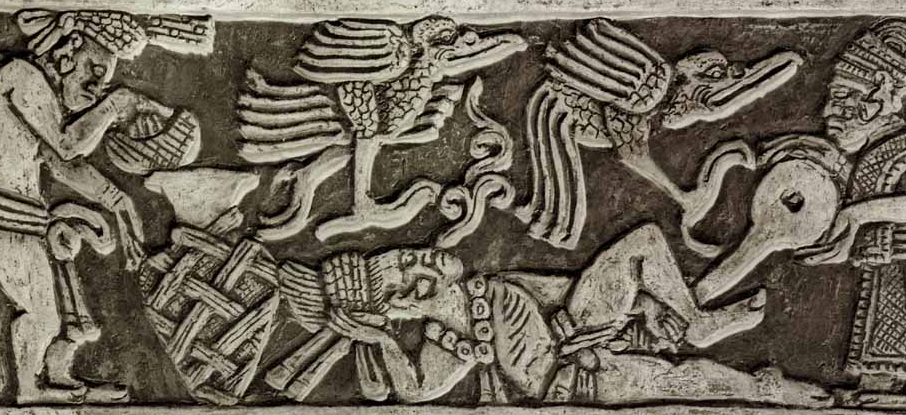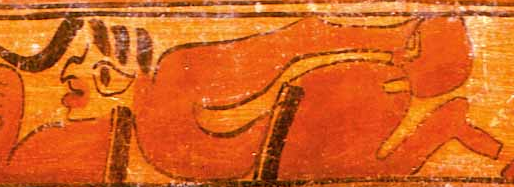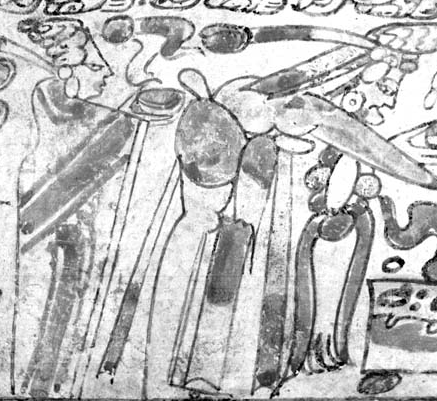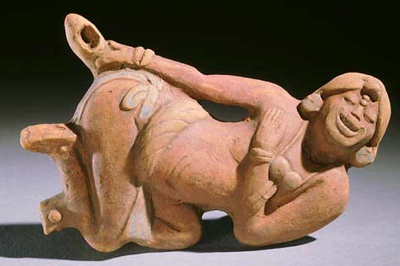Vision Quest #2: The Rainbow Enema May 31, 2013
Author: Beach Combing | in : Medieval , trackbackHow could a ‘serious’ bizarrist ignore Brian Stross and Justin Kerr’s 1990 exploratory article ‘Notes on the Mayan Vision Quest by Enema’? After all, in this piece the two intrepid Meso-American scholars make the case that enemas were used to pump hallucinogenic substances into the bodies of Mayan visionaries. And the image above (and the several below) should leave you in no doubt that the Mayans gave enemas; some early Spanish accusations of Meso-American sodomy might be thus explained.
In fact, Stross and Kerr were not the first to suggest that the Mayans had employed hallucinogenic enemas: pumping a drug up into the rectum is fast and efficient, in that it avoids the stomach (nausea) and the liver (which breaks down the hallucinogenic elements). Other scholars had come to similar conclusions looking at Mayan art. Likewise, comparative work with nineteenth-century and modern Amerindian culture show that similar methods continued and continue to be used. For example, ‘Huichol shamans take an infusion of peyote rectally by the use of a deer bladder and a femur bone’.
But Stross and Kerr did go into greater detail as to just what was contained in the mysterious infusion. By observing the jar in the background of the first image, for example, they made several deductions.
The enema substance may have been transported in liquid form, given the large size of the jar. It is difficult to think of why this would be the case unless some of the ingredients included fermentation based alcohol. It is conceivable that the heavy jar was transported empty of liquid, and that the materials were mixed with liquid on the spot; but unless a large quantity was used at a time, the reason for carrying such a jar is rather a mystery. Possibly the specific ingredients of the enema fluid were better controlled if transported in liquid form, perhaps their identity more readily kept secret from the uninitiated.
Now alcohol has been sometimes mixed with an American hallucinogenic of choice, datura, in Yucatec known evocatively as ‘the rainbow god’. Datura is also associated with visions of ‘serpents’, something particularly valued in the Mayan tradition and something that seems to be portrayed in the head image above where a serpent is spewing out of the subject’s mouth.
BTW please don’t try any of this at home.
Beach will be moving next on his vision quest onto toads. Any other unusual hallucinogens: drbeachcombing AT yahoo DOT com
An interesting final note. Stross and Kerr suggest that the enema giver and his assistant in the head scene above is non-Mayan. Is this part of the better magic mushrooms on the other side of the fence phenomenon?
25 Mar 2016: Bruce T writes in ‘the main ingredient in Mayan territory was chicha, corn beer. In Central Mexico it was pulque, the fermented maguey juice that is the basis for tequila. Peyote is rare in the tropics, but not in the drier lands of Central Mexico, where it normally grows in and around limestone outcroppings. However, it was widely traded. Psilocybin mushrooms of various types are found throughout Mesoamerica. People still make tea from them for the effects. It would be quite easy to go with an enema if you were so inclined. The Mesoamerican world had an abundance of hallucinogens at their disposal and found ritual use for most of them. Morning Glory seeds contain a chemical very closely related to LSD, they were used throughout the region, along with the above mentioned peyote, the skin of Amanita mushrooms smoked with strong tobacco, and the ever weird Salvia Divinorum, which is said to deliver a short NDE like experience by modern users, and of course, datura. Some or all could be used in an enema, and probably were. From what I gather the religious use of enema’s in mass ritual around the Maya occurred during the bloodletting ceremony where the leader pierced his foreskin with a stingray spine attached to a rope bearing thorns. It would have been something to behold. A version of the alcoholic enema still occurs on college campuses in the US. About once a year you hear of a fraternity pledge dying of alcohol poisoning after participating in alcohol enemas as part of hazing during rush week.






